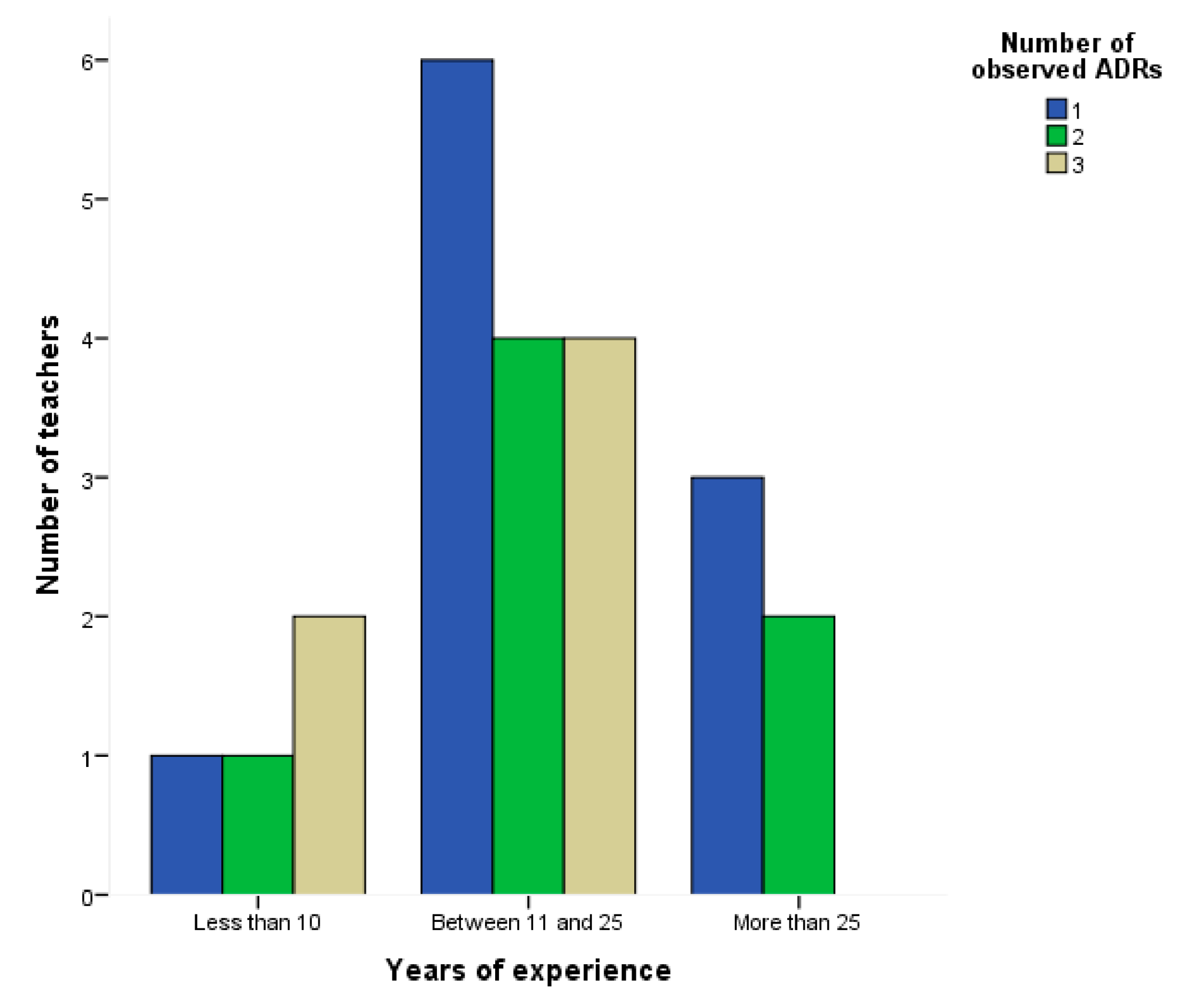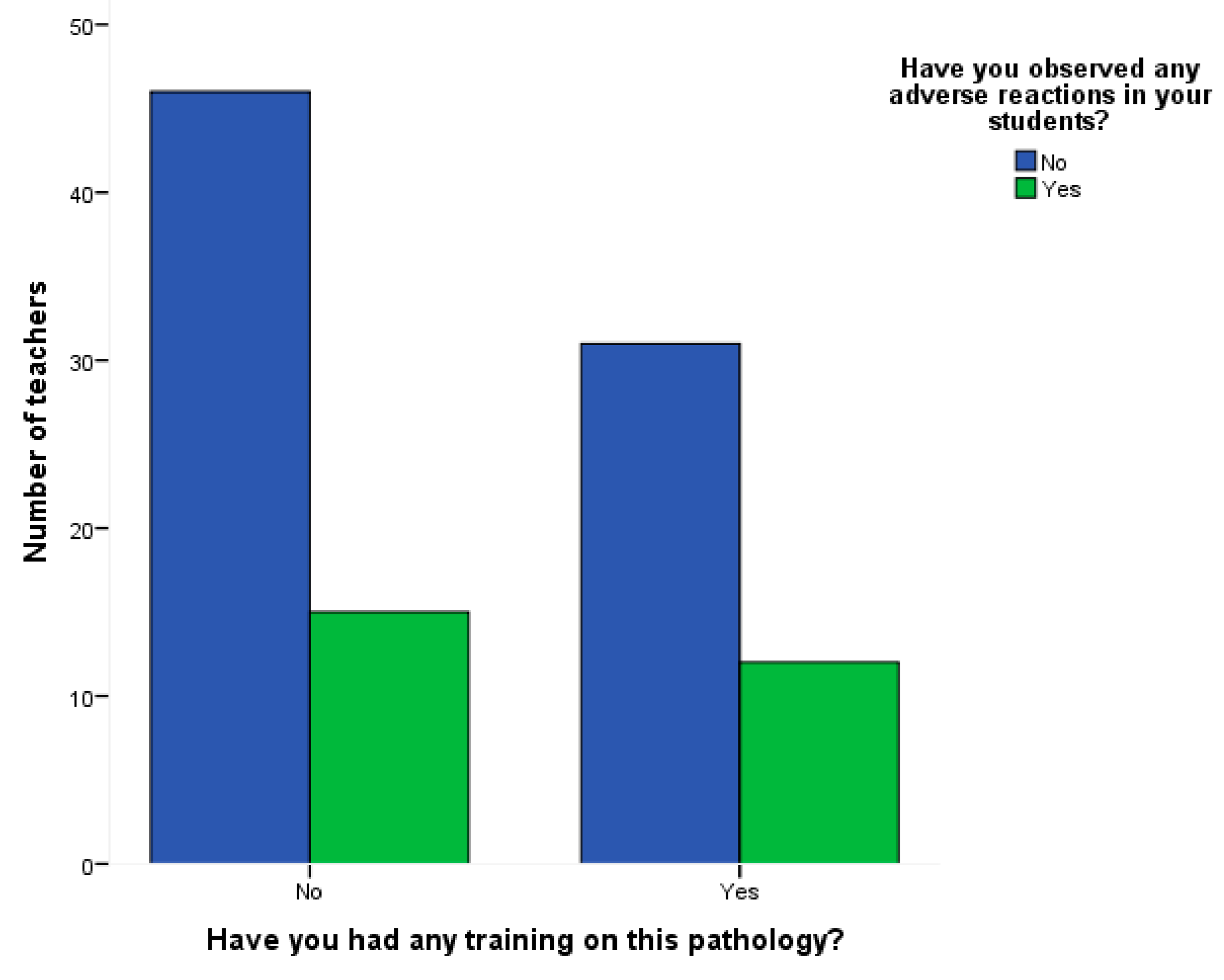The Perception of Primary School Teachers Regarding the Pharmacotherapy of Attention Deficit Hyperactivity Disorder
Abstract
1. Introduction
2. Materials and Methods
2.1. Development of the Data Collection Instrument
2.2. Study Population and Data Collection
2.3. Statistical Analyses
3. Results
4. Discussion
Limitations
5. Conclusions
Author Contributions
Funding
Institutional Review Board Statement
Informed Consent Statement
Data Availability Statement
Acknowledgments
Conflicts of Interest
References
- American Psychiatric Association. APA Diagnostic and Statistical Manual of Mental Disorders, 5th ed.; American Psychiatric Association: Washington, DC, USA, 2013. [Google Scholar]
- NICE. Attention Deficit Hyperactivity Disorder: Diagnosis and Management. 2018. Available online: https://www.nice.org.uk/guidance/ng87 (accessed on 17 September 2020).
- Faraone, S.V.; Larsson, H. Genetics of attention deficit hyperactivity disorder. Mol. Psychiatry 2019, 24, 562–575. [Google Scholar] [CrossRef]
- French, W.P. Assessment and treatment of attention-deficit/hyperactivity disorder: Part 1. Pediatr. Ann. 2015, 44, 114–120. [Google Scholar] [CrossRef]
- Oliveira, L.; Medeiros, M.; Serrano, A. PHDA: Afinal, qual a sua origem? Uma revisão dos fatores etiológicos. Rev. Port. Da Pedagog. 2017, 51, 43–61. [Google Scholar] [CrossRef][Green Version]
- Polanczyk, G.V.; Willcutt, E.G.; Salum, G.A.; Kieling, C.; Rohde, L.A. ADHD prevalence estimates across three decades: An updated systematic review and meta-regression analysis. Int. J. Epidemiol. 2014, 43, 434–442. [Google Scholar] [CrossRef]
- Bolea-Alamañac, B.; Nutt, D.J.; Adamou, M.; Asherson, P.; Bazire, S.; Coghill, D.; Heal, D.; Müller, U.; Nash, J.; Santosh, P.; et al. Evidence-based guidelines for the pharmacological management of attention deficit hyperactivity disorder: Update on recommendations from the British Association for Psychopharmacology. J. Psychopharmacol. 2014, 28, 179–203. [Google Scholar] [CrossRef]
- Troksa, K.; Kovacich, N.; Moro, M.; Chavez, B. Impact of central nervous system stimulant medication use on growth in pediatric populations with attention-deficit/hyperactivity disorder: A review. Pharmacother. J. Hum. Pharmacol. Drug Ther. 2019, 39, 665–676. [Google Scholar] [CrossRef] [PubMed]
- Lee, W.J.; Lee, T.A.; Pickard, A.S.; Caskey, R.N.; Schumock, G.T. Drugs associated with adverse events in children and adolescents. Pharmacotherapy 2014, 34, 918–926. [Google Scholar] [CrossRef]
- Storebø, O.J.; Pedersen, N.; Ramstad, E.; Kielsholm, M.L.; Nielsen, S.S.; Krogh, H.B.; Moreira-Maia, C.R.; Magnusson, F.L.; Holmskov, M.; Gerner, T.; et al. Methylphenidate for attention deficit hyperactivity disorder (ADHD) in children and adolescents—Assessment of adverse events in non-randomised studies. Cochrane Database Syst. Rev. 2018, 5, 29744873. [Google Scholar] [CrossRef] [PubMed]
- Havey, J.M.; Olson, J.M.; McCormick, C.; Cates, G.L. Teachers’ perceptions of the incidence and management of attention-deficit hyperactivity disorder. Appl. Neuropsychol. 2005, 12, 120–127. [Google Scholar] [CrossRef]
- Lee, J.; Grizenko, N.; Bhat, V.; Sengupta, S.; Polotskaia, A.; Joober, R. Relation between therapeutic response and side effects induced by methylphenidate as observed by parents and teachers of children with ADHD. BMC Psychiatry 2011, 11, 70. [Google Scholar] [CrossRef] [PubMed]
- Sciutto, M.J.; Terjesen, M.D.; Kučerová, A.; Michalová, Z.; Schmiedeler, S.; Antonopoulou, K.; Shaker, N.Z.; Lee, J.; Alkahtani, K.; Drake, B.; et al. Cross-national comparisons of teachers’ knowledge and misconceptions of ADHD. Int. Perspect. Psychol. Res. Pract. Consult. 2016, 5, 34–50. [Google Scholar] [CrossRef]
- Blotnicky-Gallant, P.; Martin, C.; McGonnell, M.; Corkum, P. Nova Scotia teachers’ ADHD knowledge, beliefs, and classroom management practices. Can. J. Sch. Psychol. 2015, 30, 3–21. [Google Scholar] [CrossRef]
- EMA. Spontaneous Adverse Drug Reactions—Subgroup Report; European Medicines Agency: Amsterdam, The Netherlands, 2018.
- Hazell, L.; Shakir, S.A.W. Under-reporting of adverse drug reactions. Drug Saf. 2006, 29, 385–396. [Google Scholar] [CrossRef] [PubMed]
- WHO. Minimum Requirements for a Functzional Pharmacovigilance System; World Health Organization: Geneva, Switzerland, 2010. [Google Scholar]
- Scurti, V.; Romero, M.; Tognoni, G. A plea for a more epidemiological and patient-oriented pharmacovigilance. Eur. J. Clin. Pharm. 2012, 68, 11–19. [Google Scholar] [CrossRef] [PubMed]
- EMA. 2018 Annual Report on EudraVigilance for the European Parliament, the Council and the Commission; European Medicines Agency: Amsterdam, The Netherlands, 2019.
- Hasan, S.S.; Bal, N.; Baker, I.; Kow, C.S.; Khan, M.U. Adverse drug reaction reporting and prescribing trends of drugs for attention deficit hyperactivity disorder in primary care england, 2010–2019. J. Atten. Disord. 2021, 108705472199755. [Google Scholar] [CrossRef] [PubMed]
- Romanini, L.S.M. Perturbação de Hiperatividade com Défice de Atenção: Importância do Envolvimento Parental no Percurso Escolar—Estudo de Caso Comparativo. Ph.D. Thesis, Instituto Politécnico de Castelo Branco, Castelo Branco, Portugal, 2012. [Google Scholar]
- Chang, L.-Y.; Wang, M.-Y.; Tsai, P.-S. Diagnostic accuracy of rating scales for attention-deficit/hyperactivity disorder: A meta-analysis. Pediatrics 2016, 137, e20152749. [Google Scholar] [CrossRef]
- Kelly, B.D. Attention-deficit hyperactivity disorder: A clinical review of the concept, diagnosis and management. Ir. J. Psychol. Med. 2018, 35, 157–161. [Google Scholar] [CrossRef]
- DGEEC; DSEE. Perfil do Docente 2016/2017; Direção-Geral de Estatísticas da Educação e Ciência: Lisboa, Portugal, 2018.
- Ramtvedt, B.E.; Aabech, H.S.; Sundet, K. Minimizing adverse events while maintaining clinical improvement in a pediatric attention-deficit/hyperactivity disorder crossover trial with dextroamphetamine and methylphenidate. J. Child Adolesc. Psychopharmacol. 2014, 24, 130–139. [Google Scholar] [CrossRef] [PubMed]
- Michelson, D.; Buitelaar, J.K.; Danckaerts, M.; Gillberg, C.; Spencer, T.J.; Zuddas, A.; Faries, D.E.; Zhang, S.; Biederman, J. Relapse prevention in pediatric patients with ADHD treated with atomoxetine: A randomized, double-blind, placebo-controlled study. J. Am. Acad. Child Adolesc. Psychiatry 2004, 43, 896–904. [Google Scholar] [CrossRef]
- Tobaiqy, M.; Stewart, D.; Helms, P.J.; Williams, J.; Crum, J.; Steer, C.; McLay, J. Parental reporting of adverse drug reactions associated with attention-deficit hyperactivity disorder (ADHD) medications in children attending specialist paediatric clinics in the UK. Drug Saf. 2011, 34, 211–219. [Google Scholar] [CrossRef]
- Gregório, J.; Cavaco, A.M.; Lapão, L.V. How to best manage time interaction with patients? Community pharmacist workload and service provision analysis. Res. Soc. Adm. Pharm. 2017, 13, 133–147. [Google Scholar] [CrossRef] [PubMed]
- Martins, S.F.; Van Mil, J.W.F.; Da Costa, F.A. The organizational framework of community pharmacies in Europe. Int. J. Clin. Pharm. 2015, 37, 896–905. [Google Scholar] [CrossRef] [PubMed]
- Cordina, M. Preparing the health workforce to enhance medication safety. Res. Soc. Adm. Pharm. 2019, 15, 1381–1382. [Google Scholar] [CrossRef] [PubMed]
- Fabio, R.A.; Caprì, T.; Iannizzotto, G.; Nucita, A.; Mohammadhasani, N. Interactive avatar boosts the performances of children with attention deficit hyperactivity disorder in dynamic measures of intelligence. Cyberpsychology Behav. Soc. Netw. 2019, 22, 588–596. [Google Scholar] [CrossRef] [PubMed]



Publisher’s Note: MDPI stays neutral with regard to jurisdictional claims in published maps and institutional affiliations. |
© 2021 by the authors. Licensee MDPI, Basel, Switzerland. This article is an open access article distributed under the terms and conditions of the Creative Commons Attribution (CC BY) license (https://creativecommons.org/licenses/by/4.0/).
Share and Cite
Gregório, J.; Ferreira, R.; Fernandes, A.S. The Perception of Primary School Teachers Regarding the Pharmacotherapy of Attention Deficit Hyperactivity Disorder. Int. J. Environ. Res. Public Health 2021, 18, 6233. https://doi.org/10.3390/ijerph18126233
Gregório J, Ferreira R, Fernandes AS. The Perception of Primary School Teachers Regarding the Pharmacotherapy of Attention Deficit Hyperactivity Disorder. International Journal of Environmental Research and Public Health. 2021; 18(12):6233. https://doi.org/10.3390/ijerph18126233
Chicago/Turabian StyleGregório, João, Raquel Ferreira, and Ana Sofia Fernandes. 2021. "The Perception of Primary School Teachers Regarding the Pharmacotherapy of Attention Deficit Hyperactivity Disorder" International Journal of Environmental Research and Public Health 18, no. 12: 6233. https://doi.org/10.3390/ijerph18126233
APA StyleGregório, J., Ferreira, R., & Fernandes, A. S. (2021). The Perception of Primary School Teachers Regarding the Pharmacotherapy of Attention Deficit Hyperactivity Disorder. International Journal of Environmental Research and Public Health, 18(12), 6233. https://doi.org/10.3390/ijerph18126233







